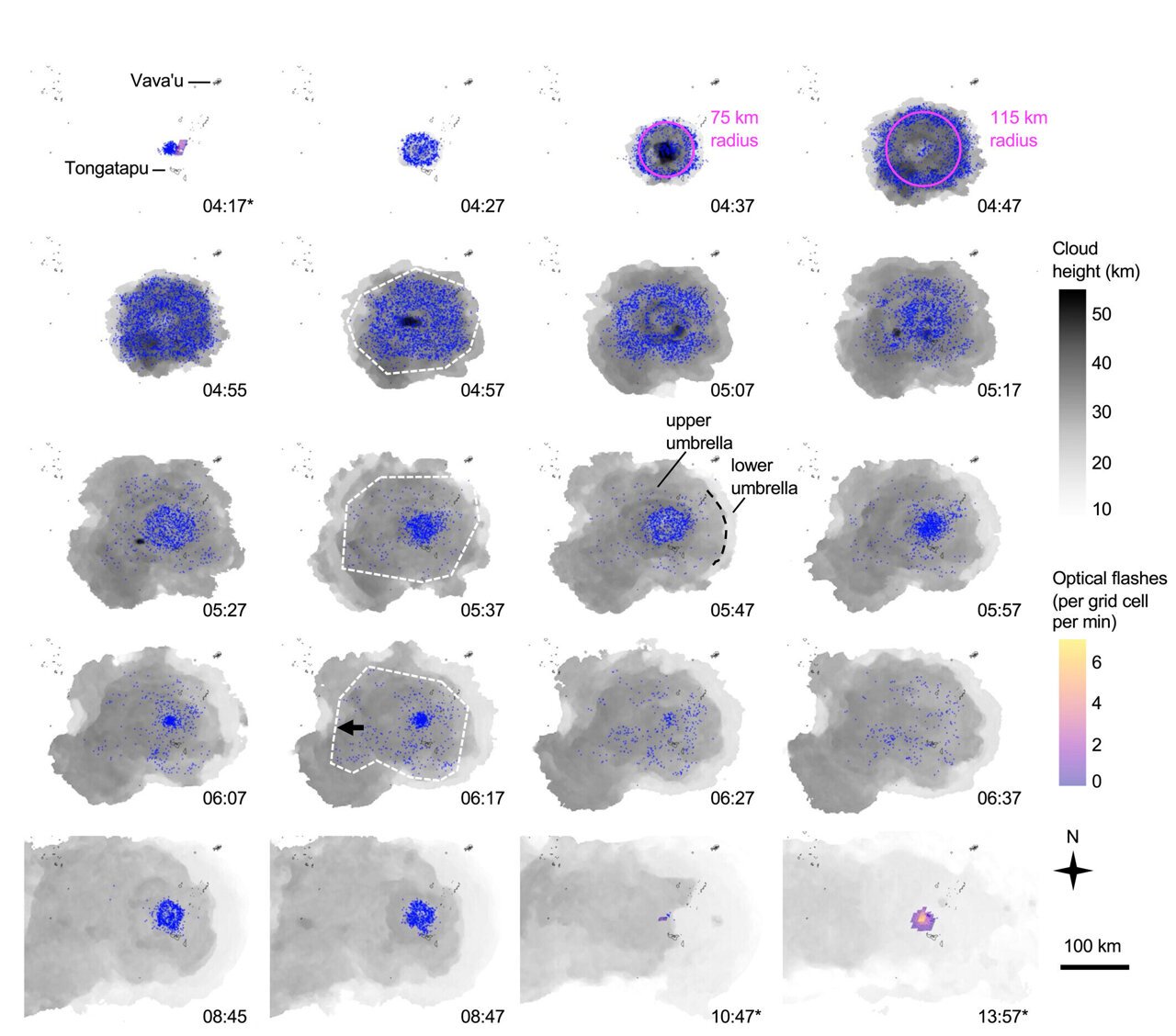The eruption of the Hunga Volcano in Tonga on January 15, 2022, has set new records and created an extraordinary thunderstorm. A recent study revealed that this eruption resulted in the most intense lightning ever recorded. The volcanic plume produced nearly 200,000 lightning flashes throughout the eruption, reaching a peak of over 2,600 flashes per minute.
The eruption of this submarine volcano in the southern Pacific Ocean generated a massive plume consisting of ash, water, and magmatic gas, which soared to a height of at least 58 kilometers (36 miles). While the towering plume provided valuable information about the scale of the eruption, it also obstructed the view of the vent from satellites, making it challenging to monitor the eruption’s progress.
However, by analyzing high-resolution lightning data from four different sources, scientists were able to gain insights into the eruption’s various phases and the unusual weather it created. This study marks the first time these four sources were combined to examine the volcanic plume.
Alexa Van Eaton, a volcanologist at the United States Geological Survey who led the study, described the eruption as triggering a “supercharged” thunderstorm of unprecedented nature. This phenomenon occurred because the powerful expulsion of magma from the volcano coincided with its eruption through the shallow ocean. The interaction between volcanic ash, supercooled water, and hailstones within the plume led to electrifying collisions and the formation of lightning.
By utilizing sensors that measure light and radio waves, scientists were able to track the lightning flashes and estimate their altitudes. The eruption produced just over 192,000 lightning flashes, consisting of nearly 500,000 electrical pulses, with a peak rate of 2,615 flashes per minute. Some of the lightning even reached previously unseen altitudes in Earth’s atmosphere, reaching between 20 to 30 kilometers (12 to 19 miles) high.
The study’s findings have significant implications for monitoring volcanic activity and issuing ash hazard advisories to aircraft. It demonstrates a new tool for rapidly monitoring volcanoes and enhances the United States Geological Survey’s role in providing critical information for aviation safety.
The study, conducted by Alexa Van Eaton and her team, was published in Geophysical Research Letters. This scientific journal publishes concise reports with immediate implications across various Earth and space sciences.
According to Van Eaton, the eruption of Hunga Volcano unveiled the ability of volcanic plumes to create lightning conditions that surpass those seen in regular meteorological thunderstorms. This discovery indicates that volcanic eruptions can produce more extreme lightning than any other type of storm on Earth.
The lightning observations not only provided information about the eruption’s duration but also shed light on its behavior over time. Initially thought to last only a couple of hours, the eruption actually generated volcanic plumes for at least 11 hours, a fact discerned by analyzing the lightning data.
The researchers identified four distinct phases of eruptive activity based on plume heights and lightning rates, offering insights into monitoring and predicting aviation-related hazards during major volcanic eruptions. This includes better understanding of ash cloud development and movement.
Gaining reliable information about volcanic plumes during the early stages of an eruption, especially for remote and submarine volcanoes, is challenging. However, incorporating lightning observations, among other long-range observations, can enhance early detection and aid in ensuring the safety of aircraft and individuals.
In addition to the intensity of the lightning, the researchers were fascinated by the concentric rings of lightning that expanded and contracted around the volcano. These rings were of a scale unprecedented in meteorological storms, and their presence puzzled the scientists. The lightning rings, some as wide as 250 kilometers, formed due to the intense turbulence caused by the plume injecting a significant amount of mass into the upper atmosphere. This turbulence created waves in the volcanic cloud, which the lightning seemed to “surf” and propagate outward.
Moreover, the eruption of Hunga Volcano represents a style of volcanism known as phreatoplinian, where a substantial volume of magma erupts through water. This eruption style had previously only been identified in the geological record and had never been observed with modern instruments. The Hunga eruption changed that, providing a rare opportunity to witness this type of volcanic activity in real-time.
The magnitude and uniqueness of these findings make the eruption of Hunga Volcano truly captivating, akin to unearthing a dinosaur and witnessing it walk on four legs, as described by Van Eaton. It is an awe-inspiring phenomenon that leaves a profound impression.
Source: American Geophysical Union
